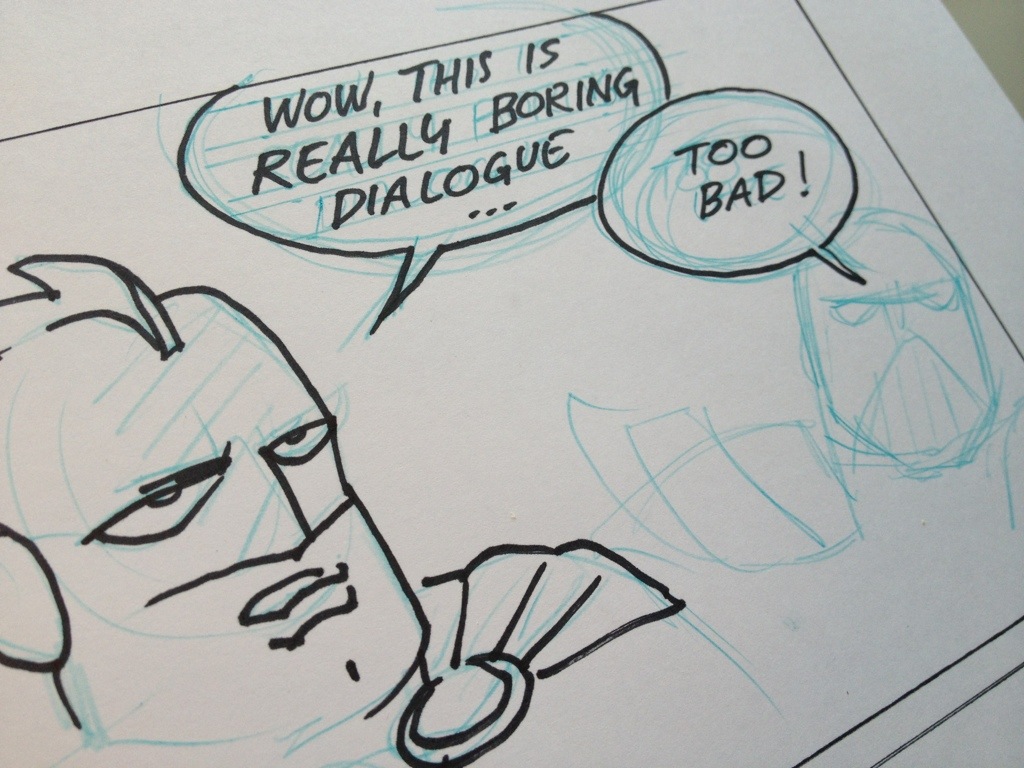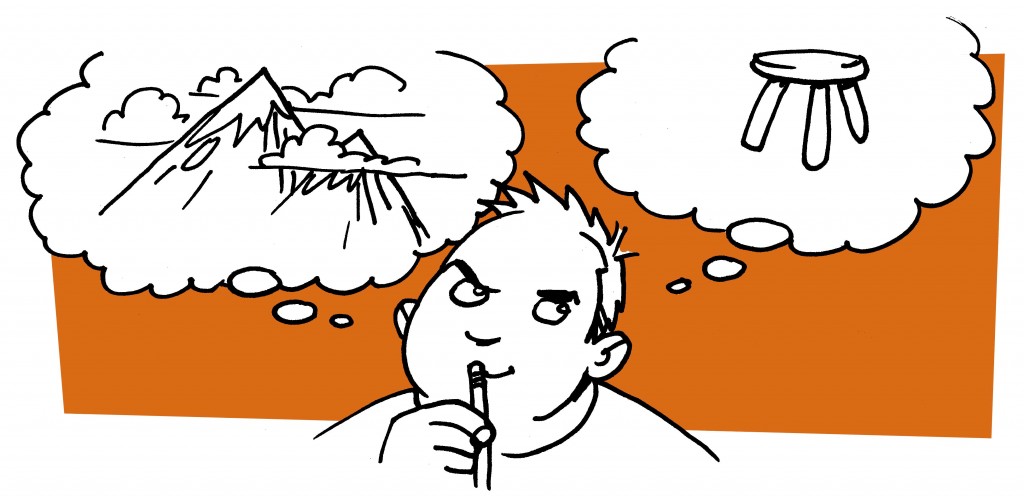Perspective drawing and backgrounds for cartoonists – Teaser for episode 6 of the Comics for Beginners tutorial series! Sign up for full video.
How to Write & Draw Comics

Here are 5 ways to write better dialogue:
Why is your character speaking? What is his motivation, the will behind his words. Maybe he wants to show off how much he knows, maybe he wants to insult the other, impress, convince or distract. Maybe he just wants to be left alone. Whatever the will may be, it will affect how the character speaks.
Long, elobarate speeches is for Shakespeare and Bond villains.
When conversations go “question – answer – question – answer” it feels like treading water. Especially mundane questions like “How was your day?” or “Wonder WHO the killer is?” deserve no answer. Try letting the other character answer with a question – their OWN project, their own will. Like “Did you feed the cat?” or “Where’s my coffee cup?”. Skip the banalities, create conflict instead.
The professor and the boxer should NOT sound the same! But for effect, you might twist the klichés once in a while and have the barbarian warrior speak like a philosopher.
Remember to vary the length, the tone and the purpose of the word ballons. Just like the panels should have variations in them, the dialogue should keep the readers on their toes, be changing organically. Not the same three-sentence structure in every ballon.
Hope these tips where helpful! If you haven’t already, be sure to join our newsletter and get more free content and tips on how to write and draw comics.
Writer/artist Palle Schmidt talks about his methods for coming up with story ideas, writing in his underwear, talking to himself and how to solve story problems with the use of balloons! What are YOUR story generation tips? Please share!

When you are telling a story in the comics medium, it is important to be able to convey emotion and expression in your characters. More important than cars, cityscapes, menacing monsters and cool costumes, is how the characters interact. How they express themselves.
A superhero might express himself in a striking pose. A seductive witch may use her body in another fashion. But the face is what ultimately draws you in to a character and into the story.
As a cartoonist, you can get away with a whole lot, if you can just learn to draw two things well: hands and faces. Those are the two things we human beings use the most to express ourselves. And luckily, most of us have those things attached to our own body!
Since Google Images, it seems effortless to find any sort of reference you need. While that may be true, I think we sometimes spend too much time surfing for a specific pose or expression, when we could just as easily pull up a gadget that has been around for centuries: A mirror.
Of course you shouldn’t draw yourself in every panel. But it is a good idea to study your own face (you could also use me as a reference) for clues as to how the mouth curls when you are sad or how you quizically raise your eyebrows or frown . Apply the same facial expression to your characters, and you have a great way of conveying the same emotion on the page.
If, like me, you have a desk lamp that can be adjusted, it is also very easy to find a reference for dramatic lighting on a face. The darker the room, the better.
I recommend sitting down and drawing your own hands as well, even just for practice. The more you master this, the better a visual storyteller you will be. Just remember that we don’t all look alike, so change the features to suit the character you are drawing.
You want to learn how to draw facial expressions and hand gestures? Put the comics away, turn off Google and pull out a mirror.
 When you are starting out in a new field, like making comics, it’s a good idea to start small.
When you are starting out in a new field, like making comics, it’s a good idea to start small.But what about that big, epic graphic novel you have in you? You want to make an impact, right? True. But if you want to have even the slightest chance of succeeding, you need to pace yourself, get better before you throw all you’ve got after a 120 page graphic novel.
You don’t start your running with a marathon. You run a mile. Then, when that starts to become easy, you run two. You slowly build your running skills.
And skill is not the only thing you build. Confidence is equally important. If you start a huge project and don’t finish, it will feel like failure. You did not achieve what you set out to do.
If you set small goals, the chance of success is much bigger. And success is what builds your confidence, which again builds your skills.
You’ll never make it to the finish line, if you don’t build some muscle first. You need skill, dicipline and craftmanship.
Even with a five-page story, you will no doubt want to redraw page 1 when you get to page 4. This is a good thing! It means you are learning, getting better. But I urge you to move on, finish it. And take whatever you’ve learned and apply it to your next project.
And when you DO finish, share your achievement. Put it online or get it out in a fanzine. Take pride in your work, however small. And always be improving, learning, gaining more and more confidence.
The way to do that is to start with something you can actually achieve. Something small.